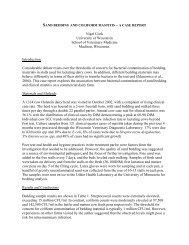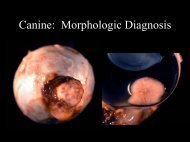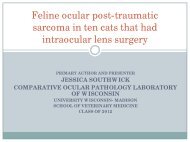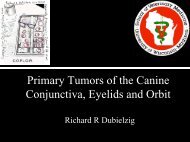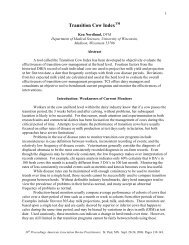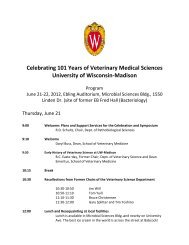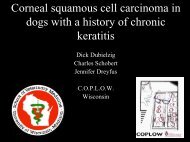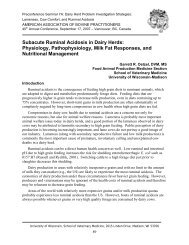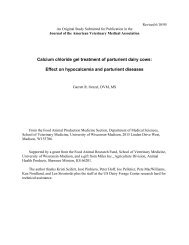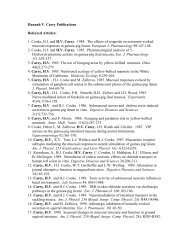Salmonellosis in Cattle: Is There Anything New - University of ...
Salmonellosis in Cattle: Is There Anything New - University of ...
Salmonellosis in Cattle: Is There Anything New - University of ...
Create successful ePaper yourself
Turn your PDF publications into a flip-book with our unique Google optimized e-Paper software.
Preconvention Sem<strong>in</strong>ar 7: Dairy Herd Problem Investigation Strategies<br />
Type B – typhimurium, agona<br />
Of Recent Concern: S. typhimurium DT 104 really is S. enterica var<br />
Typhimurium DT104. It is a phage type DT (dist<strong>in</strong>guished type) 104, with an<br />
antibiotic resistance gene that is chromosomally coded and <strong>in</strong>volves <strong>in</strong>tegrons. It<br />
has a s<strong>in</strong>gle 60-megadalton plasmid that gives it a unique plasmid pr<strong>of</strong>ile.<br />
Resistance to ampicill<strong>in</strong>, chloramphenicol, streptomyc<strong>in</strong>, sulfonamides and<br />
tetracycl<strong>in</strong>e gives it its name - R-type ACSSuT. The R-type ACSSuT pattern is<br />
considered a good marker for phage type DT-104 <strong>in</strong> the US and is the test most<br />
commonly used <strong>in</strong> this country. R-type ACSSuT pattern is not always DT-104.<br />
Also not all DT-104’s have the same resistance pattern. The resistance to<br />
chloramphenicol <strong>in</strong>cludes florfenicol. It was first detected <strong>in</strong> cattle <strong>in</strong> the UK and<br />
NW US at about the same time <strong>in</strong> the late 1980’s. DT-104 is not a superbug per<br />
se but the case fatality rate among cattle and calves <strong>in</strong> a case-control study <strong>in</strong> the<br />
UK was 40-60% (higher figure <strong>in</strong> calves). Infected animals may shed <strong>in</strong> higher<br />
numbers and there are cl<strong>in</strong>ically normal carriers. <strong>There</strong> is some debate whether<br />
the prevalence <strong>of</strong> this serotype is <strong>in</strong>creas<strong>in</strong>g (appears so <strong>in</strong> the UK) or whether it<br />
peaked <strong>in</strong> 1995 and has decl<strong>in</strong>ed s<strong>in</strong>ce. In 4 <strong>of</strong> 5 outbreaks <strong>in</strong> the US, association<br />
was made between cattle or consumption <strong>of</strong> dairy products and the people<br />
<strong>in</strong>fected. This phage type has been isolated from cattle <strong>in</strong> Wiscons<strong>in</strong>.<br />
Type C – newport, montevideo, kentucky, <strong>in</strong>fantis<br />
Type D – dubl<strong>in</strong><br />
Epidemiologically, this isolate was not common outside <strong>of</strong> CA until the late 80’s,<br />
emerg<strong>in</strong>g for the first time <strong>in</strong> NY, PN and OH <strong>in</strong> 1988. Unlike other serotypes, S.<br />
enterica Dubl<strong>in</strong> affect older calves (8 weeks <strong>of</strong> age or older) which is atypical for<br />
salmonellosis, presents as pneumonia and septicemia rather than the primarily<br />
diarrheal syndrome that is more commonly recognized.<br />
Type E – anatum<br />
The common salmonella serotypes <strong>of</strong> concern to bov<strong>in</strong>e practitioners – S. anatum, dubl<strong>in</strong>,<br />
montivideo, typhimurium) are now classified <strong>in</strong>to a s<strong>in</strong>gle species, Salmonella enterica. For<br />
example, what was S. typhimurium is now Salmonella enterica serovar Typhimurium or S.<br />
Typhimurium.<br />
<strong>University</strong> <strong>of</strong> Wiscons<strong>in</strong>, School <strong>of</strong> Veter<strong>in</strong>ary Medic<strong>in</strong>e, 2015 L<strong>in</strong>den Drive, Madison, WI 53706<br />
6



